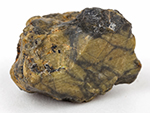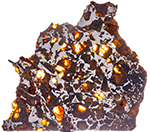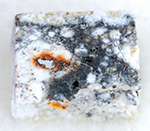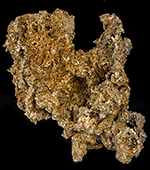
|
Sale 101
Manuscript & Collectibles Sale
| Lot |
Photo |
Description |
Realized |
Lot 651 |
 |
Martian Meteorite Complete 3.53 Gram Stone. Meteorites from the planet Mars, so identified because of their chemical analysis and age, are rare because the original larger meteorite broke up high in the Earth's atmosphere and the small pieces continued to burn as they hit the Earth. In 2005 in the Sahara desert of Algeria a number of small individual meteorites with a total weight of less than 200 grams were found and submitted for analysis. This Martian meteorite (named NWA 4783 with other NWA pairings) was found to be a rare achondrite basaltic (volcanic) Martian Shergotite with vesicular gas pockets and trapped melt inclusions and represents one of the freshest Martian Shergotites found. Complete, greenish, and uncut meteorite, 20 x 13 mm, weighing 3.53 grams with 100% of its original black fusion crust on the 20mm of the top side. Estimate $1,400 - 1,800
View details and enlarged photo
| Realized
$1,200 |
Lot 652 |
 |
Tatahouine Vesta Meteorite 14.3 Grams. The moon, Mars and Vesta are the only planetary bodies in our solar system where we can positively identify meteorites that originated from their surface. Vesta is a very large asteroid with a diameter of over 326 miles. A gigantic impact crater at its South Pole is the source of all Vesta meteorites. Tatahouine was named for the city nearest its fall in 1937, Tatahouine, Tunisia. (For Star Wars fans, Tatahouine is famous for being the name of Luke Skywalker's home planet.) The meteorite Tatahouine, called a Diogenite, comes from deep inside the huge impact crater. This 14.3 gram end cut is 23 x 14 x 14 mm, polished on one side and with its natural surface on the other. It is a lovely green and very large for a Tatahouine, most of which are less than 3 grams. High olivine content and virtually a virgin rock from Vesta. Its green color with black shock lines make it instantly recognizable. Estimate $1,250 - 1,500
View details and enlarged photo
| Realized
$1,320 |
Lot 653 |
 |
Gem Quality Admire Pallasite Meteorite 108.5 Grams. This large complete section is 3.75 x 3.25 inches, weighing 108.5 grams, with more than a dozen clear translucent yellow-green olivine crystals, some approaching gem quality. The Admire Pallasite, named for its discovery in 1881 in Admire, Lyon County, Kansas is one of the most beautiful of all known pallasites and is unique in pallasites in the olivine crystals, having a characteristic called chatoyancy, which is the change of luster within a gemstone due to the way the crystals reflect light. This rare occurrence is caused by tiny void tubes which appear like the effect of fiber optics when the gemstone is cut parallel to the tubes and can be observed in some olivine crystals of the Admire Pallasite when viewed in low light as the crystals seem to turn on and off by themselves. Estimate $1,000 - 1,300
View details and enlarged photo
| Unsold |
Lot 654 |
 |
Oriented Silhote-Alin Meteorite With Regmaglypts, 263.5 Grams. This good size, 31/8 x 1.5 x .75 inch, 263.5gram Sikhote-Alin iron- nickel meteorite is oriented with regmaglypts, small crater-like impressions that formed by ablation of Troilite when the meteorite was streaking through the sky at high temperature, and a number of geometric layers and somewhat sharp corners, resulting from the explosive breakup in the atmosphere. It is even oriented with delicate flow lines, flowing mostly in one direction and creating lips on some of the sharp edges. Having fallen on Feb. 12, 1947 in Siberia, Sikhote-Alin iron-nickel meteorites are the best preserved of all known iron-nickel meteorite. Displayed on a magnetic stand. Estimate $800 - 1,000
View details and enlarged photo
| Unsold |
Lot 655 |
 |
Meteorite Campo Del Cielo 7 Pounds. Aesthetically- pleasing 5.5 x 4 x 2 inch, 7 pound new Campo del Cielo iron-nickel meteorite with several distinct regmaglypts (thumbprints) formed when the meteor passed through Earth�s atmosphere and the troilite (iron sulfide) in the meteorite melted before the meteorite struck the earth. First recorded by the Spanish in 1576, the huge fall of Campo del Cielo (Valley of the Sky) iron-nickel meteorites occurred thousands of years earlier in Argentina. This desk sized iron-nickel meteorite would make an "out of this world" paperweight. Estimate $550 - 750
View details and enlarged photo
| Realized
$420 |
Lot 656 |
 |
Own A Piece Of A Comet 1.6 Gram Murchison Meteorite. A piece of one of the most important and well studied meteorites ever discovered. It fell in Australia shortly before 11 A.M. on Sept. 28, 1969. This extremely rare carbonaceous chondrite type 2 meteorite is one of the most primitive meteorites known, virtually unchanged since being formed at the same time as the solar system 4.57 billion years ago. Murchison meteorites contain 12 per cent water and many organic compounds which makes it very different from most of the meteorites which originate in the asteroid belt. NASA planetary scientists consider Murchison to be cometary in origin. It contains over 92 different amino acids, whereas on earth there are only 19 Amino acids. This rare cut section weighs 1.6 grams and is 26mm x 16mm, housed in a 1.25 x 1.25 inch white plastic box and an 8 x 6 inch Riker mount. Polished on both sides, it is black in color with lighter gray spherical chondrules. Estimate $500 - 700
View details and enlarged photo
| Realized
$750 |
Lot 657 |
 |
Pallasovka Pallasite Meteorite 69.4 Grams. Pallasites are known as gemstones from space as they contain olivine crystals, the gem form being known as Peridot within the matrix of the iron-nickel. Pallasovka is one of the scarcer Pallasites with only a single meteorite weighing 198 Kg being found in 1749 by Peter Pallas, after whom it was named. This 69.4 gram polished slice is 55 x 45 x 6mm, with more than 50% of its iron- nickel surface covered with olivine crystals, a few of them being slightly translucent in yellow and orange colors. The quality of the olivine crystals is excellent but the translucence is reduced because of the thickness of the slice. Estimate $500 - 650
View details and enlarged photo
| Unsold |
Lot 658 |
 |
Most Beautiful Lunar Meteorite NWA 5000 0.5 Gram Section. Lunar meteorites were created when a large meteorite crashed into the moon millions of years ago and vaporized moon rock and sand particles and ejected them from the moon, sending them eventually to earth. This 8 x 6 x 3.5 mm of NWA 5000 section is large enough to observe the distinctive white and black clasts that make this Lunar Meteorite the most beautiful and desirable. Found in Southern Morocco in 2007 this is the only Lunar highland Gabbro available for study. It comes from an unexplored part of the moon. Accompanied with a Hupe Collection card of authenticity. Estimate $275 - 375
View details and enlarged photo
| Realized
$263 |
Lot 659 |
 |
Outstanding 15 Pound Specimen of Pyrite, Fantastic Natural Crystal Formations. An impressive large cabinet specimen of pyrite that simply dazzles. This example has a wonderful natural formation of interlocking iron sulfide crystals in a compelling organic shape full of recesses and bridges. Commonly called "fools gold" given its color and appearance, this is far from a foolish example of this fantastic mineral. It absolutely impresses in its gleam and formation and would make for a significant addition to any collector or decor. 8½ x 12½ x 6" and 15.2 pounds. Estimate $1,000 - 1,500
View details and enlarged photo
| Realized
$625 |
|
|